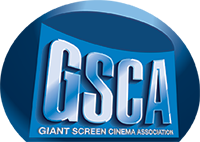
By James Hyder
February 9, 2022—Douglas Trumbull, the innovator behind revolutionary visual effects in such classic science-fiction films as 2001: A Space Odyssey, Close Encounters of the Third Kind, and Blade Runner, died on February 7, in Albany, NY, from complications of mesothelioma. He was 79.
Although Trumbull’s Hollywood credits are well known, his connections to the giant-screen industry are deep and actually pre-date the creation of the IMAX film format in 1970. In the early 1960s, the twenty-year-old Trumbull was working as an illustrator for Graphic Films, which would become a leading producer of GS films a decade later. Trumbull’s paintings were used in Graphic’s To the Moon and Beyond, which director Stanley Kubrick saw at the 1964-65 World’s Fair in New York City, as he was starting work on 2001: A Space Odyssey (1968).
Kubrick hired Trumbull to work on the film, and one of his first projects was producing the readouts for ubiquitous computer displays in the film’s spacecraft. His talent and creativity soon led him to take on other projects, none more innovative or influential than the slit-scan Star Gate sequence that is the climax of the film.
After 2001, Trumbull worked on a few other Hollywood features, but became disenchanted with the constraints of the studio system and focused on developing new cinematic technologies. In the late 1970s and early ’80s he invented Showscan, which ran 5/70 film at 60 frames per second. The result was an ultra-realistic experience with none of the flicker or motion judder of conventional 24-fps movies. Rejected by the studios as too expensive and impractical to install in hundreds or thousands of theaters, Showscan gained limited use in theme parks and motion simulation rides, and the Showscan camera system received a Scientific and Technical Academy Award.
In the early 1990s, Trumbull directed the Back to the Future ride for the Universal Studios theme park, which was shot on 15/70 film and projected on dome screens with IMAX projectors at three of the studio’s parks. He described some of the numerous challenges of making the film in a presentation to IMERSA at its 2018 Summit in Columbus, OH.
The success of the ride led to Trumbull’s Ridefilm Company being acquired by IMAX Corporation in 1994. Trumbull was vice chairman of IMAX for three years, and helped develop the plan that took the company public in 1996.
Photo courtesy James Hyder
With the advent of digital cinema in the late 2000s, Trumbull looked to ways to expand the cinematic experience again, using a combination of stereo 3D, high frame rate, and high brightness projection. In 2014, he unveiled his Magi system, which uses native 3D in 4K at 120 fps, and an innovative technique he dubbed “cadence,” which had not been used in previous systems. Each eye sees 60 fps, but alternately, with a black frame in one eye while the other sees an image. He claimed that the blank frames, which are also present in 24 fps cinema, eliminate the “soap opera” effect that other HFR systems are often criticized for.
To demonstrate Magi, Trumbull produced a short film, UFOTOG, which he presented at the 2014 conference of the Giant Screen Cinema Association in Toronto.

GSCA staff Kelly Germain, Tammy Barrett, and Eileen
Pheiffer with Doug Trumbull at the GSCA 2014 Conference in Toronto
Honors Trumbull received over his sixty-year career include three Oscar nominations from the Academy of Motion Picture Arts and Sciences and the Academy’s Gordon E. Sawyer Award (2012); the Society of Motion Picture and Television Engineers’ Presidential Proclamation (2011) and Progress Medal (2016); the President’s Award from the American Society of Cinematographers (1995); the Visual Effects Society’s Georges Méliès Award (2012); and IMERSA’s Lifetime Achievement Award (2018).
In his 2018 book Space Odyssey, about the making of 2001, author Michael Benson says that when Trumbull started working on the film in 1964, “he’d arrived knowing how to use an airbrush but will little knowledge of photography. He would leave as one of the handful of truly innovative practitioners of optics-based visual effects in the world. Trumbull had a flair for solutions, which he devised one after the other in rapid succession. He was intuitive, he was precise, and when the results weren’t good, they were excellent, and when they weren’t excellent, they were outstanding.”
Douglas Trumbull is survived by his wife, Julia Hobart Trumbull, daughters Amy Trumbull and Andromeda Stevens, four step-children, nine grandchildren, one great-grandchild, a sister, two half-sisters, and a step-sister.
